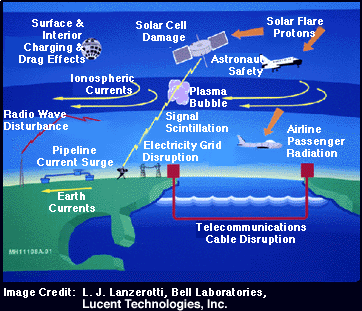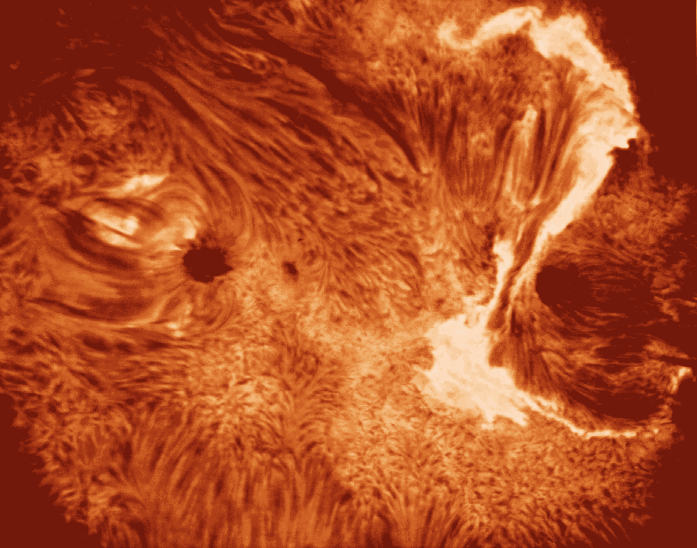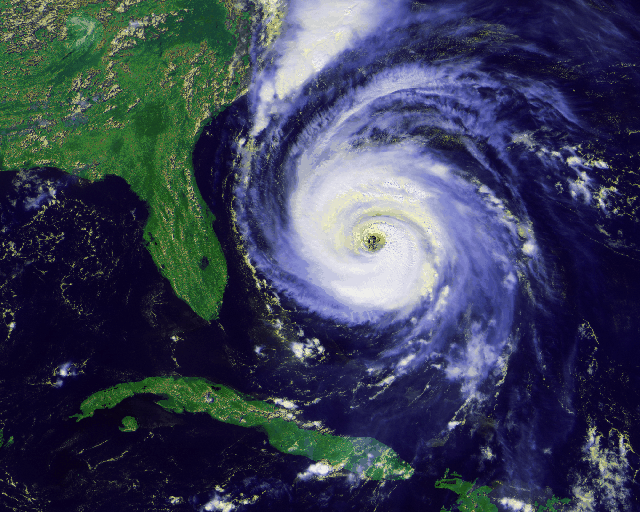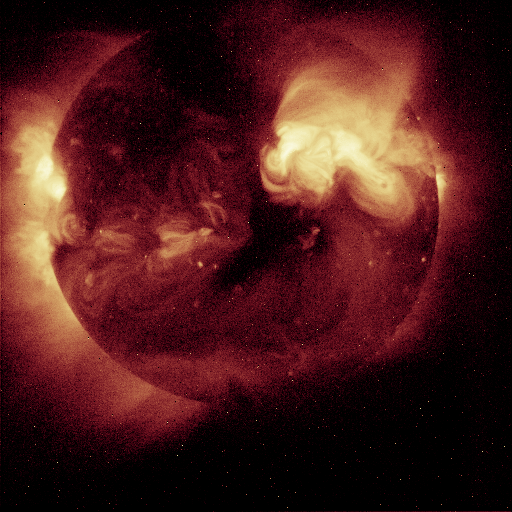|
- Think about it - What is a storm and what does it mean to your
life?
- Is there any difference between the familiar effects of a hurricane
and the disruptions caused by solar “storms,” which disrupt power
grids, cause fuzzy television signals, and generate a potential
and deadly nightmare for astronauts?
A storm is a natural event, a huge release or transfer of energy
in which matter is quickly transported, particle by particle,
to different places. It is a source of destruction and awe.
There are also personal effects, ways that storms affect individuals,
families, and towns around the globe. Reread the last sentence,
and, instead of thinking about storms here on the Earth’s surface
that are associated with clouds, consider storms that are composed
of streams of particles that come from the Sun.
Just as we need early warning systems for hurricanes, tornadoes,
and severe storms, it is necessary to have warnings about “space
storms.” That is why ACE (Advanced Composition Explorer) and the
study of space weather are important in our everyday lives.
ACE has, in addition to other scientific instruments, a space
weather early warning system, located where it provides as much
as an hour's notice of potentially dangerous solar activity. Launched
Aug. 25, 1997, with nine specialized instruments, it will keep
an eye on the Sun from a
spot where the gravitational pull of
the Earth and Sun and ACE's centripetal force balance each other,
about 1 million miles from Earth and 92 million miles from the
Sun.
- --------------------------------------------------------
- But how is space weather
- really like Earth weather?
--------------------------------------------------------
- These quantities in space are analogous to
- common Earth measurements and features:
| Earth |
Space |
| Wind speed |
Solar wind speed |
| Wind direction |
Particle direction |
| Isobars |
Magnetic flux lines |
| Weather systems |
Magnetic field areas (ex: van Allen belts) |
- By checking in with the daily space weather forecasts, just as
one might check in with the Weather Channel, the everyday effects
of CMEs (coronal mass ejections) and other space events can be
determined before they disrupt your life in a negative way. Additionally,
you could find out when the most spectacular auroras might be
occurring! But what are some of the factors that make a difference
in space?
What about wind speed and wind direction? On Earth, we determine
how fast and in what direction air molecules move, and generalize
that they move from areas of high concentration to areas of low
concentration. The solar wind comes from particles ejected from
the Sun. The greater the speed and density of the particles, the
greater the wind, just as for air molecules on Earth. Therefore,
measuring the solar wind is important.
In terrestrial weather forecasting, local properties, such as
terrain, elevation, and surrounding climate conditions, must be
considered. Near a planet or other celestial body, the local magnetic
environment is just as
important. The Earth’s magnetosphere is
a dynamic region extending thousands of miles into space, protecting
the Earth most of the time from these energetic particles. It
is important to measure its specific structure (like examining
terrain and elevation), as well as local and surrounding variations
in the magnetosphere (similar to looking at typical surrounding
climates). Amazingly enough, when the magnetosphere of a body
is distorted in even a minor way by energized particles from a
solar event, the particles themselves can be channeled toward
the Earth’s surface, giving off heat, radio waves, and light,
similar to the channeling into the destructive forces of hurricanes
or tornadoes. The particles in space weather are subatomic and
in Earth weather are molecules, but the effects can be equally
unsettling.
Do you depend on satellites for anything? Of course you do! Everything
from cellular phone calls to TV to tornado warnings on TV depend
on satellites functioning properly.
---------------------------------------------------------
- How does Space Weather
- affect you?
- ---------------------------------------------------------
- Did YOU know:
- During space weather disturbances, small magnetic field changes
in near-Earth space produce changing electrical and magnetic fields
that are felt at the Earth's surface.
- Homing pigeons have been observed to become confused during such
disturbances and can even be lost.
|
|
|
Actual event descriptions on the net:
The Sun's activity causes large changes in the Sun's plasma and
energetic particle populations, and these changes are responsible
for the space weather that affects Earth. Space weather can impact
the upper atmosphere and may influence long-term climate trends.
The effects are related to CMEs, solar energetic particles (SEPs),
and coronal holes. The largest storms occur when a fast CME hits
Earth shortly after its shock arrives.
Geomagnetic storms (magnetic storms on Earth due to solar activity)
produce the Aurora borealis and Aurora australis (the Northern and Southern lights) but can also cause a variety
of undesirable consequences. Associated with magnetic storms are
electrical current surges in power lines, interference in the
broadcast of radio, television, and telephone signals, and problems
with defense communications. Odd behavior in air and marine navigation
instruments has been observed and a compass anywhere on Earth
is certainly affected. These storms are known to alter the atmospheric
ozone layer. Even increased pipeline corrosion has been attributed
to them.
In case you were wondering. . . How does an event so far away cause change in the current
going through power lines? You may be familiar with Faraday’s
Law of induction which tells us that a change in a magnetic field
causes or induces a change in local electrical fields. This can
be seen by moving a bar magnet through an electrically charged
coil. The Earth behaves like a bar magnet and has a magnetic field
that extends well beyond our atmosphere into space. Based on what
you know or have just learned in this paragraph, what if the magnetic
field of the Earth were altered? That’s right, electrical currents
would be altered. Mathematically, this is described by:
 =-d =-d /dt. /dt.
- (where
 is the induced EMF, d is the induced EMF, d is the rate of change of magnetic flux, and dt is the time interval
for the d is the rate of change of magnetic flux, and dt is the time interval
for the d to happen) to happen)
- In other words, the magnetic flux or changing magnetic flux induces
an electro-motive force (EMF) for a given circuit. In some cases,
electrical currents can be induced through pipes or pipelines
if they are not grounded!
Major solar activity is a very serious concern in space flight
because:
- Communications may be disrupted.
- Large solar disturbances heat the upper atmosphere, causing it
to expand and increasing drag on spacecraft in low Earth orbits,
shortening their orbital lifetime. Spacecraft could potentially
tumble and burn up in the atmosphere.
- Intense SEP events contain very high levels of radiation, more
than a million times the normal daily dose we receive on Earth.
Radiation sickness can result when astronauts are in space, especially
during missions to the moon and Mars, where the Earth’s magnetosphere
no longer protects them.
High-energy solar protons can produce increased radiation in the
atmosphere at altitudes where supersonic aircraft fly. This is
especially true for flights over the north and south magnetic
poles, areas unprotected by the Earth's magnetic field where the
radiation has direct access to the atmosphere. To reduce the risk
to aircraft crews and passengers, and to reduce risk to the aircraft,
routine forecasts and alerts are sent through the Federal Aviation
Administration so that a flight in potential danger can consider
what course of action to take to minimize radiation exposure.
The National Oceanic and Atmospheric Administration (NOAA) forecasts
high-speed solar wind and solar particle events.
The continuous broadcast of solar wind, magnetic field, and SEP
data from ACE is expected to allow very accurate forecasts of
major activity up to one hour beforehand. In particular; ACE will
detect large CMEs and their associated shocks before they reach
Earth, just like weather stations on Earth measure major storms
as they move across the continent. This will remove much of the
guesswork from space weather forecasts, and represents a major
advance in NOAA's forecast ability as well as a furthering of
our understanding of the scientific processes involved.
Geomagnetic storms are a natural hazard that NOAA’s Space Environment
Center (SEC) forecasts for the public's benefit.
- --------------------------------------------------------
- So as we move toward a dependence upon satellite transmissions
to communicate, and additionally send more spacecraft and people
into space, can you understand that the study of space weather
will someday be as important as forecasting a hurricane?
- --------------------------------------------------------
CREDITS:
- Pat Keeney
|
- GESSEP Program
|
- Daniel Hortert
|
- GESSEP Program
|
- Dr. Eric Christian
|
- ACE Deputy Project
- Scientist
|
- Dr. John Krizmanic
|
- Astroparticle Physicist
|
Beth
Barbier
|
- ACE Outreach Specialist
|
|
|

 =-d
=-d /dt.
/dt. is the induced EMF, d
is the induced EMF, d is the rate of change of magnetic flux, and dt is the time interval
for the d
is the rate of change of magnetic flux, and dt is the time interval
for the d to happen)
to happen)


